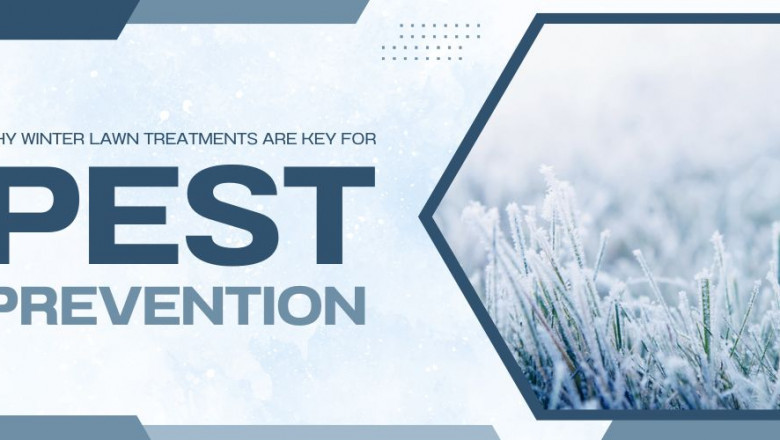views
Winter may seem like a time to take a break from lawn care, but it’s actually a crucial season for preventive measures, especially when it comes to pest control. Cold weather doesn’t eliminate pests; in many cases, it simply forces them into a dormant state, only to reappear stronger when temperatures rise. By focusing on winter lawn treatments, you set up your lawn for better growth and fewer pest issues when spring arrives.
Furthermore, it offers many benefits that aren’t immediately obvious but go a long way in maintaining a healthy, pest-free lawn year-round. Here’s why investing in winter lawn treatment is key for pest prevention and can give your lawn a head start in the new year.
The Importance of Winter Lawn Treatment
Winter lawn treatments are important in controlling pests like mosquitoes, rodents, bed bugs, and termites, even though they may not be directly associated with the lawn. By making an unfavorable environment for these pests, winter lawn treatments can help reduce the risk of infestations and protect both your outdoor and indoor spaces.
Here’s how winter lawn treatments impact pest control for these specific pests:
-
Mosquito Control
-
Reducing breeding grounds: Winter lawn treatments that address standing water, such as improving drainage and aerating the soil, prevent moisture accumulation, essential for mosquito breeding.
-
Eliminating weedy vegetation: Pre-emergent herbicides prevent the growth of weeds that can create shady, moist environments where mosquitoes tend to hide and lay eggs.
-
Creating a less hospitable environment: By ensuring that the soil and lawn are healthy and not overly saturated, winter treatments make your yard less appealing to mosquitoes looking for moist areas.
-
Rodent Control
-
Removing food and shelter sources: Winter lawn treatments like clearing debris, leaves, and excess thatch reduce hiding spots and food sources for rodents, such as seeds and small insects.
-
Improving soil and lawn health: A dense, healthy lawn leaves fewer open spots for rodents to burrow or nest. Winter fertilization and overseeding help create this denser ground cover.
-
Deterring rodents with fewer populations: Since areas with insect populations attract rodents, treatments that reduce insects can also indirectly reduce rodent activity.
-
Bed Bug Prevention
-
Discouraging outdoor trandfer: Bed bugs can enter homes by hitching a ride on luggage, pets, or clothing. A well-maintained lawn with reduced pest activity and clear entry points can lower the chances of pests, including bed bugs, being brought indoors.
-
Eliminating attraction of other hosts: Rodents carrying bed bugs are less likely to invade a well-maintained lawn. Reducing rodent presence with winter treatments can indirectly prevent bed bugs from reaching the home.
-
Termite Control
-
Addressing mulch and wood debris: Termites are attracted to decomposing wood, so clearing dead wood, leaves, and debris from the lawn prevents termites from finding early food sources and shelter near the home.
-
Managing soil moisture: Termites thrive in moist conditions. Winter lawn treatments, such as proper drainage and balanced soil moisture, make the environment less attractive to termites.
-
Maintaining a buffer zone: Treating soil areas around the yard and keeping mulch or wood materials away from the home’s foundation are preventative barriers against termites.
Natural Pest Prevention Through Winter Lawn Care Practices
Aside from chemical treatments, certain winter lawn care practices also play an important role in pest prevention:
-
Adjusting watering for winter: Overly wet soil during winter can attract pests and lead to fungal growth. Reduce watering frequency in winter to maintain the proper moisture balance, which prevents pests and keeps your lawn healthier.
-
Cleaning debris and thatch: Removing fallen leaves, dead grass, and other debris prevents pests from finding shelter in your lawn. Clearing these areas makes your yard less attractive to pests, looking for winter habitats, reducing the chances of a pest buildup by spring.
-
Aerating the soil: Aerating your lawn in late fall or early winter prevents soil compaction, making it less appealing to pests that thrive in dense soil. Aeration improves nutrient absorption, strengthens grassroots, and promotes a healthier lawn.
Prep Your Lawns for Winter
In conclusion, winter is not the time to neglect your lawn—it’s the season to act strategically with lawn treatment in Arkansas. Taking proactive steps during the colder months ensures your lawn is ready to thrive when the temperatures rise. With the professional, you can effectively reduce pest populations, create an unwelcoming environment for infestations, and promote a healthier, more resilient lawn.
Don’t wait until pests become a problem—start your winter lawn care today and enjoy the benefits of a pest-free yard and home as the seasons change.






















Comments
0 comment